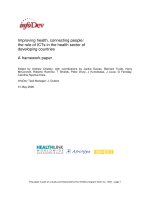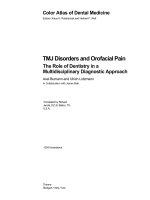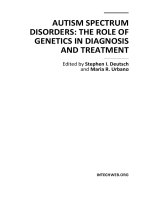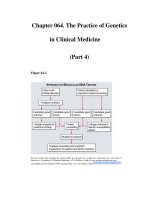THE ROLE OF SURGERY IN HEART FAILURE - PART 4 ppt
Bạn đang xem bản rút gọn của tài liệu. Xem và tải ngay bản đầy đủ của tài liệu tại đây (102.6 KB, 2 trang )
Valve Pathology in Heart Failure: Which Valves
Can Be Fixed?
Martinus T. Spoor, MD
y
, Steven F. Bolling, MD
*
University of Michigan, Ann Arbor, MI, USA
Congestive heart failure (CHF) is a significant
health burden whose impact is increasing around
the world. As our population ages, medical
advances that have extended our average life
expectancy have also left more people living with
chronic cardiac disease than ever before. In the
United States alone, there are nearly 4.9 million
suffering with heart failure with over 500,000 new
patients diagnosed each year. Despite the signif-
icant improvements with medical management,
patients who have CHF are repeatedly readmitted
for inpatient care, and the vast majority will die
within 3 years of diagnosis [1]. Heart transplanta-
tion has evolved to become the gold standard
treatment for patients who have symptoms of
severe congestive heart failure associated with
end-stage heart disease. From an epidemiologic
perspective, this treatment is ‘‘trivial’’ because
less than 2800 patients in the United States are
offered transplantation due to limitations of age,
comorbid conditions, and donor availability.
New surgical strategies to manage patients with
severe end-stage heart disease have therefore
evolved to cope with the donor shortage in heart
transplantation and have included high-risk coro-
nary artery revascularization [2–9], cardiomyo-
plasty [10,11], and high-risk valvular repair or
replacement [12].
Surgical treatment of mitral valve disease
Geometric mitral reconstruction
Functional mitral regurgitation (MR) is a sig-
nificant complication of end-stage cardiomyopathy
and it may affect almost all patients who have heart
failure as a preterminal or terminal event. Its
presence in these patients is associated with pro-
gressive ventricular dilatation, an escalation of
CHF symptomatology, and significant reductions
in long-term survival estimated between only 6 and
24 months [2].
A firm understanding of the functional anat-
omy of the mitral valve is fundamental to the
management of MR in heart failure. The mitral
valve apparatus consists of the annulus, leaflets,
chordae tendineae, and papillary muscles as well
as the entire left ventricle (LV). Thus the mainte-
nance of chordal, annular, and subvalvular conti-
nuity is essential for the preservation of mitral
geometric relationships and overall ventricular
function. As the ventricle fails, the progressive di-
latation of the LV gives rise to MR, which begets
more MR and further ventricular dilatation
(Fig. 1). With postinfarction remodeling and lat-
eral wall dysfunction, similar processes combine
to result in ischemic mitral regurgitation. Left un-
corrected, the end result of progressive MR and
global ventricular remodeling is similar regardless
of the etiology of cardiomyopathy. Incomplete
leaflet coaptation, loss of the zone of coaptation,
and regurgitation develop secondary to alter-
ations in the annular–ventricular apparatus and
ventricular geometry [3,4]. As the mitral valve an-
nulus increases in size, an increasing amount of re-
dundant mitral leaflet tissue, associated with
a reduction of the size of the area of coaptation
y
Formerly from the Section of Cardiac Surgery,
University of Michigan, Ann Arbor, Michigan.
* Corresponding author. Section of Cardiac Surgery,
University of Michigan, 1500 East Medical Center
Drive, Ann Arbor, MI 48103.
E-mail address: (S.F. Bolling).
1551-7136/07/$ - see front matter Ó 2007 Elsevier Inc. All rights reserved.
doi:10.1016/j.hfc.2007.04.008 heartfailure.theclinics.com
Heart Failure Clin 3 (2007) 289–298
Patients who Have Dilated Cardiomyopathy Must
Have a Trial of Bridge to Recovery (Pro)
Johannes Mueller, MD
a,
*
, Gerd Wallukat, PhD
b
a
Berlin Heart, Berlin, Germany
b
Max Delbrueck Center, Berlin, Germany
Healing of idiopathic dilated cardiomyopathy
(IDC) by drug therapy has not yet been successful.
Mechanical unloading of the heart by an assist
device is the only available measure that allows
the heart a period of relative rest in which
functional improvement may be achieved by
interrupting the vicious circle of increasing wall
tension and functional impairment. The hearts of
a subset of patients who have IDC improve to
normal or near-normal function when supported
by a device. It is believed that under unloading
conditions, special medical supplementation may
enhance the process of improvement [1–9].
End-stage heart failure in patients who have
dilated cardiomyopathy is characterized by vol-
ume and pressure overload of the left and/or right
ventricle. The ventricular wall and the interven-
tricular septum are stretched and therefore
thinned. The myocardial structure is severely
disturbed by a collagen composition of the extra-
cellular matrix that is out of balance [10–12].
Arrhythmia and conductance disturbances are
the consequence. Finally, because of the inability
of the heart to pump a sufficient volume of
blood to the end organs, a globally impaired
supply with oxygen is the result. Medically,
these patients are treated with full antifailure
medication, which, after a time of improvement,
cannot avoid a trend toward further deteriora-
tion in most patients [13,14]. Likewise the appli-
cation of devices with biventricular pacing
capability postpones the process of deterioration
but does not lead to long-term sustained improve-
ment of cardiac function. At this stage, cardiac
transplantation is the logical next step to keep the
patient alive. However, if a donor heart is not avail-
able, the ultima ratio is the implantation of a me-
chanical cardiac assist system, which leads to an
immediate improvement of the overall oxygen sup-
ply and of end-organ function [15,16].
Because the number of donor organs is limited
and indeed has even decreased within the past
years, there is growing significance attached to the
application of mechanical assist devices as
a method to save the lives of patients who are
facing imminent death [17].
The development of cardiac assist devices has
made much progress within the last 10 years. In
the 1980s, mainly paracorporeal devices were
available; however, in the 1990s, the partly
implantable and fully implantable pulsatile car-
diac support systems emerged and played an
increasing role (Fig. 1) [18,19]. Then, in 1998,
the first rotary blood pump was implanted [20].
Rotary pumps are significantly smaller, free of
noise, and have lower power consumption than
the pulsatile devices (Fig. 2). Most of these devices
are placed above the diaphragm and do not need
a pocket between two abdominal muscle layers
[21–23]. With these new devices, the assist device
technology has reached a status whereby the sur-
gical implantation procedure is easier than with
the former systems, and infection done of the crit-
ical problems related to the size of the devicesdno
longer plays a prominent role. The remaining
problem with these pumps alludes to throm-
boembolic events and potentially long-term effects
caused by the reduced pulsatility of the blood
* Corresponding author. Berlin Heart, Wiesenweg 10,
12247 Berlin, Germany.
E-mail address:
(J. Mueller).
1551-7136/07/$ - see front matter Ó 2007 Elsevier Inc. All rights reserved.
doi:10.1016/j.hfc.2007.05.006 heartfailure.theclinics.com
Heart Failure Clin 3 (2007) 299–315









